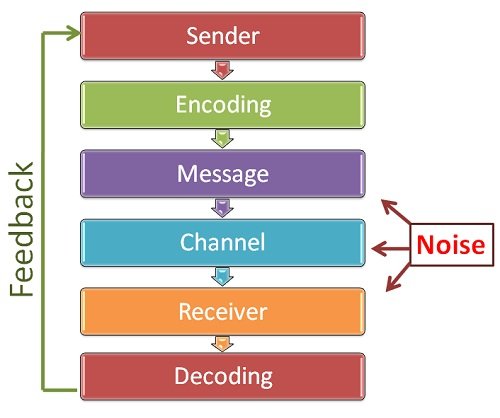The process of communication involves the systematic exchange of information between a sender and a receiver. It begins with the sender encoding a message and transmitting it through a chosen medium (e.g., verbal, written, or digital). The receiver decodes the message, interprets its meaning, and provides feedback to complete the process. Effective communication relies on clarity, the right medium, and mutual understanding while minimizing barriers like noise, misinterpretation, or distractions that can disrupt the flow of information.
Communication Process:
The communication is a dynamic process that begins with the conceptualizing of ideas by the sender who then transmits the message through a channel to the receiver, who in turn gives the feedback in the form of some message or signal within the given time frame.

- Sender
The sender is the source of the message that initiates the communication. The sender has a message or purpose of communicating to one or more people. A manager in an organization has to communicate information about the tasks to be achieved or a production deadline to be met by his subordinate employees. Without a reason, purpose, or desire, the sender has no information/message to send.
- Encoding
In the next stage, encoding takes place when the sender translates the information or message into some words, signs or symbols. Without encoding the information cannot be transferred from one person to another. In encoding the message, the sender has to choose those words, symbols or gestures that he believes to have the same meaning for the receiver. While doing so, the sender has to keep the level of the receiver in mind and accordingly communicate with him in the way the receiver understands it.
The message may be in any form that can be understood by the receiver. Speech is heard; words are read; gestures are seen or felt and symbols are interpreted. For example, there are several communications we make with a wave of the hand or with a nod of the head, a pat on the back, blinking of eyes.
- Message
Once the encoding is finished, the sender gets the message that he intends to convey. The message can be written, oral, symbolic or non-verbal such as body gestures, silence, sighs, sounds, etc. or any other signal that triggers the response of a receiver.
Message is the idea or information that the sender wants to convey. He may convey it verbally (by writing or speaking) or non-verbally (through gestures or body language). Whatever the form, the message should be clearly formed so that the objective is accomplished.
- Channel
The channel is the medium used for transmission of information or message from sender to receiver. There are various media like telephone, mail through post, internet, radio, TV, press etc. For communication to be effective and efficient, the channel must be appropriate for the message. A phone conversation is not a suitable channel for transmitting a complex engineering diagram.
An express mail may be more appropriate. The needs and requirements of the receiver must also be considered in selecting a channel. If the receiver is illiterate, sending the message through postal mail is not relevant. Similarly, you cannot select the medium of telephone, if the receiver does not have a telephone with him. Therefore, in choosing the appropriate channel, the manager must decide whether feedback is important or not.
- Receiver
The receiver is the person who senses or perceives or receives the sender’s message. There may be just one receiver or a large number of receivers. The message must be prepared with the receiver’s background in mind. An engineer in a software organization should avoid using technical terms in communicating with his family members. It should be recognized that if the message does not reach a receiver, no communication takes place. Even, when the message reaches the receiver, if he cannot understand it, again there is no communication.
- Decoding
Decoding is the process through which the receiver interprets the message and translates it into meaningful information. It may be remembered that decoding is affected by the receiver’s past experience, personal assessments of the symbols and gestures, expectations, and mutuality of meaning with the sender.
- Noise
It represents the disturbing factor in the process of communication. It interferes with effective communication and reduces clarity of the message. The message may be interpreted differently than intended by the sender. Conversing near a machine making sounds, disturbance in telephone line, physical ailment or mental distress of sender or receiver are the common causes of noise that obstruct the quality of message transmitted from sender to the receiver.
- Feedback
Feedback is receiver’s response to the sender’s message. The receiver communicates reaction to the sender through words, symbols or gestures. It is the reversal of communication process where receiver becomes the sender and sender becomes the receiver. Unless the receiver responds to the message, communication process is incomplete. Feedback helps the sender transform his message, if needed. It also allows the receiver to clear doubts on the message, ask questions to build his confidence and enables the sender to know efficiency of the message. Feedback of information makes the communication process complete.
In face-to-face communication, sender can immediately receive the feedback. Written communication, on the other hand, takes longer for the sender to receive feedback on the message.
Feedback plays important role in two-way communication. In one-way communication, sender communicates with the receiver without getting any feedback but in two-way communication, the receiver provides feedback to the sender. Though one-way communication takes less time and is more orderly (it avoids noise and chaos), feedback in two-way communication makes it more accurate and precise.